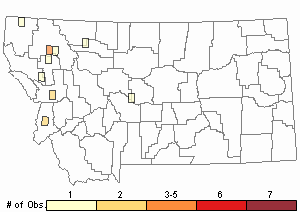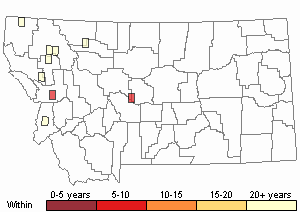View in other NatureServe Network Field Guides
NatureServe
Montana
Utah
Wyoming
Idaho
Wisconsin
British Columbia
South Carolina
Yukon
California
New York
A Syntrichia Moss - Syntrichia princeps
Other Names:
Tortula princeps
General Description
Plants: Acrocarpous (Vitt 1988). Growing in upright, crowded clumps or patches of upright shoots, green distally, russet below (Smith 1980). Stems 1-4 cm tall (occasionally taller), frequently forked, sometimes with a central strand present (Lawton 1971).
Leaves: Incurved, slightly contorted and spiraled around the stem to varying degrees when dry, curved outwardly to broadly spreading when wet, 2-4 mm in length, 1-1.5 mm in width, cupped, spatula-shaped; margins tightly rolled out and downward proximally up to 3/4 of the leaf length; leaf tips acute or sometimes cut off abruptly; costa extending into a long, saw-toothed awn, the awn mostly transparent except for the red base (FNA 2007).
Leaf Cells: Basal cells large, transparent, smooth, and fine-walled, nearly square or a little rectangular near the margins, longer interiorly, well-demarcated from the cells above; upper cells nearly square to 6-sided, somewhat swollen, each with 4-6 papillae (FNA 2007); costa in X-section with 2 guide cells, 2 adaxial cell layers, and a strong abaxial stereid band (Lawton 1971).
Diagnostic Characteristics
T. princeps differs from T. ruralis, T. papillosissima, and T. norvegia by its synoicous state (if present); otherwise by broader basal cells, and the presence of a central strand (if present) (FNA 2007).
Range Comments
North American Range
Canada: BC; USA: states west of and including MT s to AZ; Mexico (FNA 2007). In Montana, known from Flathead, Lake, Lincoln, Missoula, Park, and Ravalli Counties (Elliott 2016).
Observations in Montana Natural Heritage Program Database
Number of Observations: 16
(Click on the following maps and charts to see full sized version)
Map Help and Descriptions
Relative Density

Recency



 (Observations spanning multiple months or years are excluded from time charts)
(Observations spanning multiple months or years are excluded from time charts)
Habitat
Tree bark, soil (FNA 2007) and basic rock, on bluffs (Smith 1980). Elevation: low to medium (FNA 2007).
Reproductive Characteristics
Archegonia and antheridia usually in the same inflorescence, but apparently on separate plants occasionally. Seta 1-1.8 cm tall, red. Capsule 3-4 mm in length, russet, a little bowed, with a conspicuous neck, the peristome’s 32 reddish and papillose thread-like divisions spiraled ca 2 revolutions (FNA 2007).
Specialized vegetative propagula unknown (FNA 2007).
Stewardship Responsibility
References
- Literature Cited AboveLegend:
 View Online Publication
View Online Publication Elliott, J.C. and A.K. Pipp. 2018. A Checklist of Montana Mosses (1880-2018). Updated 3 January, 2020. Montana Natural Heritage Program, Helena, Montana. 73 pp.
Elliott, J.C. and A.K. Pipp. 2018. A Checklist of Montana Mosses (1880-2018). Updated 3 January, 2020. Montana Natural Heritage Program, Helena, Montana. 73 pp. Flora of North America Editorial Committee, eds. 2007. Flora of North America North of Mexico. Volume 27. Bryophytes: Mosses, Part 1. Oxford University Press, Inc., NY. xxi + 713 pp.
Flora of North America Editorial Committee, eds. 2007. Flora of North America North of Mexico. Volume 27. Bryophytes: Mosses, Part 1. Oxford University Press, Inc., NY. xxi + 713 pp. Lawton, E. 1971. Moss Flora of the Pacific Northwest. Hattori Botanical Laboratory. Japan: Yamabuki-cho, Shinjuku-ku, Tokyo. 362 pages plus appendices.
Lawton, E. 1971. Moss Flora of the Pacific Northwest. Hattori Botanical Laboratory. Japan: Yamabuki-cho, Shinjuku-ku, Tokyo. 362 pages plus appendices. Smith, A.J.E. 1980. The Moss Flora of Britain and Ireland. Cambridge University Press, Cambridge. 705 pp.
Smith, A.J.E. 1980. The Moss Flora of Britain and Ireland. Cambridge University Press, Cambridge. 705 pp. Vitt, D. J. Marsh, and R. Bovey. 1988. Mosses, Lichens & Ferns of Northwest North America. Seattle, WA: University of Washington Press. 296 p.
Vitt, D. J. Marsh, and R. Bovey. 1988. Mosses, Lichens & Ferns of Northwest North America. Seattle, WA: University of Washington Press. 296 p.
- Additional ReferencesLegend:
 View Online Publication
View Online Publication
Do you know of a citation we're missing? Elliot, J. C. 1993. Second checklist of Montana mosses. Unpublished report. U.S. Forest Service, Region 1. Missoula, MT. 45 pp.
Elliot, J. C. 1993. Second checklist of Montana mosses. Unpublished report. U.S. Forest Service, Region 1. Missoula, MT. 45 pp. Lawton, E. 1971. Keys for the Identification of the Mosses on the Pacific Northwest. Reprinted from 'Moss Flora of the Pacific Northwest'. Published as Supplement No. 2 of the Journal of the Hattori Botanical Laboratory. Nichinan, Miyazaki, Japan. 66 pp.
Lawton, E. 1971. Keys for the Identification of the Mosses on the Pacific Northwest. Reprinted from 'Moss Flora of the Pacific Northwest'. Published as Supplement No. 2 of the Journal of the Hattori Botanical Laboratory. Nichinan, Miyazaki, Japan. 66 pp.
- Web Search Engines for Articles on "A Syntrichia Moss"





